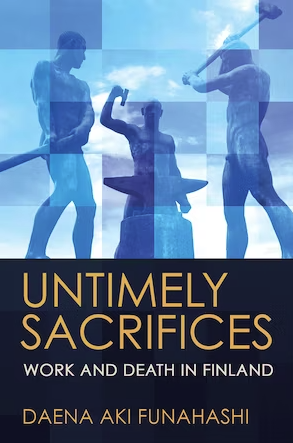For most people, Finland is not the first place that comes to mind when imagining a nation dealing with an epidemic of occupational burnout. American media frequently portrays the country as a near-utopia, with strong social welfare systems and communitarian values. In the World Happiness Report published by the UN, Finland took the number one spot for the sixth year in a row.
In 2006 and 2007, Daena Funahashi, Assistant Professor in the UC Berkeley Department of Anthropology, conducted ethnographic work in Finnish rehabilitation programs for occupational burnout. Experts at the Finnish Institute of Occupational Health (FIOH) see occupational burnout as arising out of a shift in people’s orientation to work that negatively impacts stress coping mechanisms. Rehabilitation programs, sponsored by the Finnish government, allow victims of burnout to take multi-week breaks from work in order to engage in a series of recreational and psychological therapies.
 In her newly published book, Untimely Sacrifices: Work and Death in Finland (Cornell University Press 2023) Funahashi brings classic anthropological scholarship on exchange and sacrifice to bear on contemporary concerns of state welfare, capitalism, and labor’s attrition. Turning to Finland in the early 2000s, when health experts identified occupational burnout as a symptom of Finland’s new economy, Untimely Sacrifices asks what moves individuals to give their time and energy to the point of pathological – and sometimes lethal – levels of stress.
In her newly published book, Untimely Sacrifices: Work and Death in Finland (Cornell University Press 2023) Funahashi brings classic anthropological scholarship on exchange and sacrifice to bear on contemporary concerns of state welfare, capitalism, and labor’s attrition. Turning to Finland in the early 2000s, when health experts identified occupational burnout as a symptom of Finland’s new economy, Untimely Sacrifices asks what moves individuals to give their time and energy to the point of pathological – and sometimes lethal – levels of stress.
For this interview, Nataliya Nedzhvetskaya, a Matrix Communications Scholar, asked Professor Funahashi to give readers an overview of her new book. [Responses have been edited.]
How did you get started researching this topic?
Specifically, burnout became a hot topic in Finland in the late 1990s and the early 2000s, both as a new crisis of this new economy, but also as an untimely response to contemporary challenges of the workplace that needed to be diagnosed, prevented, and managed. I became interested in what escapes from this managerial perspective, in the stories – or silences – surrounding burnout and its attendant regimes of excess, sociality, and sacrifice.
The centers themselves were interesting to explore. They had a diverse variety of experts involved. Psychologists definitely played a prominent role but so did physical and occupational therapists. There was a lot of craftwork and an emphasis on making aspirations visible by creating vision boards. There were activities that promoted how to say no and lots of relaxation therapies. A day in the forest. A day of silence. Meditation exercises. Mindfulness exercises.
Why did you choose Finland as your research site?
Nordic welfare has often been explored via a utopian lens. I wanted to explore further to see what collective regimes of labor do to our ideas about what we owe to others – and how we interact with them. Finland caught my attention because when I was looking for a place to base my project in 2006-2007, the country was in the process of making a collective effort to re-calibrate the responsibility of citizen-workers to the state.
The economic crisis of the late 1990s really hit Finland hard, as it lost the USSR as its main trading partner. It came at a bad time because Finland had been trying to join the European Union, as well as European Economic and Monetary Union, for a long time. When the economic crisis happened, it was imperative for Finland to get out of the recession quickly. The focus then, was on being “timely,” as in knowing how to act in the here and now not just as Finns, but as “Europeans” – a title with, in the context of the EU, a distinct orientation towards competitiveness.
As you see in the title of my book, timeliness –being timely – knowing how to be, knowing how to spend and save your time and energy under the exigencies of the present – became imperative. That’s when “burning out” became a national issue. Burnout came to mark those individuals who were not “timely,” individuals who were not expending themselves in ways that made sense in the workplace today, in a competitive market economy. In the book, I make the point that while Finnish health experts understood burnout as an effect of advanced capitalism, I see the condition instead as a disorder that inaugurates the rules of the economic present rather than as an effect of it. Burnout is not an unintended side effect of advanced capitalism but is part of the nature of work under advanced capitalism. Workers must be timely in order to transact in the market and receive the highest return on their labor.
When the new economy came into being, it laid out “common sense” for workers. Those who didn’t adapt to the new economy had burnout, and were “sick” workers who needed rehabilitation. This explanation, used by psychologists and economists, tries to make burnout into a coherent medical condition that can be fixed. Rather than making sense of burnout and trying to cure it, I instead use burnout as an entry point to understand the “common sense” assumptions that came with the new economy.
You use this term “martyr worker” throughout your book. Why do you use this term and how do you understand it?
Absolutely. Martyr workers, in short, are workers who fail to make their sacrifice “count” in the self-interested, economic sense. If advanced capitalism is about economic rationalism, doing something because you feel like you should or because you dare not do it, is irrational, right? It doesn’t make any economic sense. Burnout gains currency as the disorder associated with “martyr workers” in Finland, because the presumption is that those experiencing burnout are driven by ideology – the ideology of welfare and of an older work ethic that is defunct in the present.
The provocation that I’m making in the book is that, contrary to the supposed healthiness and timeliness of expending yourself based on a reasoned calculation of what time and energy you should save or spend, the individuals who attended rehabilitation programs for burnout highlighted instead the very illegibility of sociality, how the self-evident aspects of social exchange can’t be put into words. It was not what you can enumerate and put down like, “Okay, I did this. So I should be getting this back,” this tit-for-tat mentality of exchange, that moved them. It was not that which drove them to work. They revealed to me that there was something beyond what they could name that pushed them to give. In trying to track down what moved them, they found themselves unable to claim their actions as their own. This is what I found that was so different from the discourse of “self-management” that was prevalent in these rehabilitation programs. And, this is where I believe turning to anthropological scholarship on the voluntary and involuntary nature of gift exchange could broaden our understanding of the animus behind work.
We have spoken so much about the Finnish context and things that are in some ways unique, and in some ways not unique, to Finland. What do you think generalizes to other parts of the world, or to other advanced capitalist societies?
Happiness has become part of what counts toward productivity now. Rather than disciplining bodies to work harder and longer hours, we’ve now turned to the management of affect, of happiness. Being healthy is no longer enough; you have to be happy, vibrant, enthusiastic, and empowered. These are all affective words. Under advanced capitalism, what makes us “burn,” what sets us on fire, becomes the very thing that we must bring under calculative control. The demand to be happy affects post-industrial societies everywhere. It’s not enough that you are interviewed and have all the skills. You have to be extra-vibrant, chirpy, a go-getter. You’ve got to bring that X-factor.
That X-factor leads to conditions like burnout because you have to commit affectively. It’s an experiential commitment. It’s giving your all. How could you not go into overdrive and go into excess? And worse, it’s no longer an external being, an entity saying “You have to do this. You have to do that.” You have to self-start. So you become your worst enemy.
You’re asked to do two different things. You’re supposed to keep yourself in equilibrium but you’re also supposed to give your all.
Exactly. And if you burn out, you’re a spendthrift. Why couldn’t you save time or spend time in a more managed way? You’re wayward in your self-management. You don’t know yourself. You’ve overcommitted.
It strikes me that a lot of the burden here has moved from society to the individual. Individuals are increasingly tasked with knowing and communicating their own limits within a stressful work environment. Turning burnout into an individual medical condition and treating it as such stops us from considering the social conditions that create it more critically.A lot of countries all over the world are really interested in burnout and are starting to medicalize it, similar to Finland. What do you think the outcome of that will be?
In one rehabilitation program I studied, there were so many different experts involved. They have the psychologist, the social worker, the nutritionist, and the activities leader, because you have to be happy. You must have fun [laughs] – you must. So happiness becomes part of the productive economic process. It’s harnessed into the very mechanisms of capital. But then it’s not happiness anymore though, is it?
If you only think about well-being in terms of utility and productivity, you are thinking about humanity as a tool of capital. Happiness as a means to an end. If you say that happiness is a resource, you are instrumentalizing affect. That very enigmatic, human, singular condition that gives meaning to life is twisted and perverted for the sake of capital.
Together with this attention to stress and stress-related conditions like burnout, I see a rise in the clinical discourse of “self-management.” For instance, in Finland, rehabilitation for burnout was based on an “empowerment paradigm” that promoted self-awareness. Becoming self-aware was to be a pathway for clients to recognize their untimeliness and to re-conceptualize their personal and professional goals within the limits of the present. While you may not see Finland’s rehabilitative program take root in the US, for instance, we still do share a lot in terms of the growth in “happiness” and “mindfulness” industries all built on the power of the self to control itself.
How do you think your findings will shake up preconceived notions about stress and stress management?
Remember that my point here is that my interlocutors were those who were convinced that what they felt no longer made sense – what they took as the givens of social reciprocity at work no longer took on the self-evidence they once did. That’s why my focus has been on speechlessness and what focusing on that space of absence allows. In rehabilitation programs, psychologists focus on questions like, why did you do work the way you did? Why did you volunteer to help so much? Why did you do that? And what are your limits? It is as if there is this coherent you-as-a-resource that you can map out. You have the resource of your energy and time that people could translate into some kind of spreadsheet.
What was really interesting ethnographically for me was how people fell speechless exactly at those moments, when asked, “why did you do it?” Not just “why do you do it,” but, “why do you continuously do it?” The seriality of their supposed senseless, energetic waste. That’s the aspect that psychologists would call an illness. It’s ill. It’s sick to be repetitively doing something knowing that it will hurt you, that you are going to burn out from it.
You can’t stop yourself.
Exactly. Like some kind of compulsion to the point where your fire burns out. For me, as an anthropologist, witnessing these individuals in the setting of these rehabilitation centers, I saw it not as an illness but as this space of silence opening up a new question about sociality. I saw it as some kind of negativity at play in the way we engage socially.
That’s why I focused on the question of the name. What is it to confer a diagnosis? What is it to name something as an illness in a way that gives you a handle on that issue? It gives you a technique, a method, a center. And it’s productive, at least in terms of the state and the economy. The state throws money at it, you make use of all these rehabilitation centers, you populate those centers, you give jobs to experts, and you give birth to more expertise. Now you have experts on burnout. It’s very productive!
But I’m saying that such a framing doesn’t really touch upon that space where those who burn out fall speechless. A psychologist might say, “Hey, you should be doing this. You need to empower yourself. Do this. Do that.” As an anthropologist, I would say “No, we need to learn from these moments.”
This is a testament to what I witnessed. This book is really trying to give significance to these moments where we actually question why we do things. These seem to be simple and fundamental questions, almost silly questions. But I think those are the questions that touch upon philosophical, anthropological examinations of what drives us. Who authors our actions?
Based on what you find in the book, how might we rethink this public health orientation towards occupational burnout?
Rather than think about rehabilitation, we might rehabilitate work. If the problem is that these syndromes – stress and overwork and suicidal ideation – emerge because of shifts in economic policy or shifts in workplace demand, then maybe it is not the people who must be rehabilitated. Maybe we should learn from those who fall speechless, who fall “sick.” I learned from working with them the unreason of reason that tells us how we are to find happiness in an undoubtedly unreasonable world.



